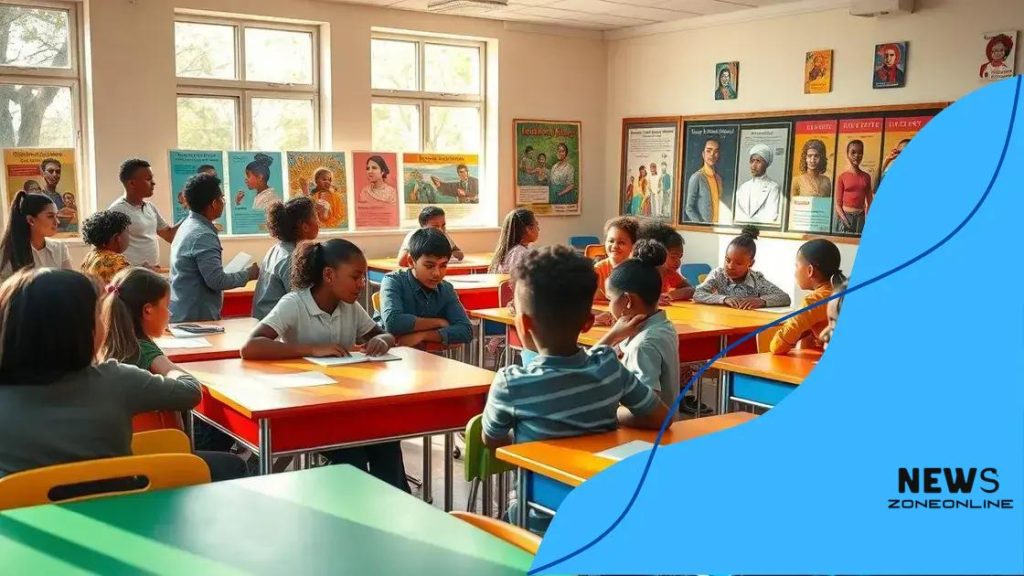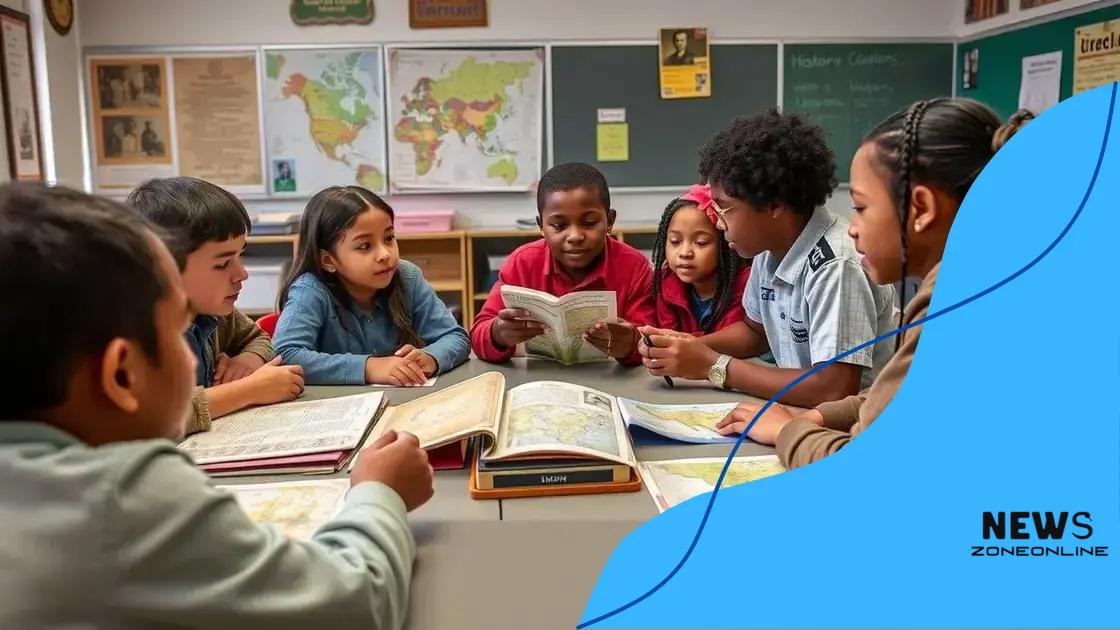K-12 inclusive history standards: shaping future education

K-12 inclusive history standards aim to enhance students’ understanding and empathy by providing diverse perspectives, ensuring that all voices are represented in the curriculum.
K-12 inclusive history standards play a crucial role in shaping how students learn about our past. They promote understanding and empathy by representing diverse experiences. Have you ever wondered how these standards impact educational outcomes?
Understanding the importance of inclusive history standards
Understanding the importance of inclusive history standards is key for modern education. These standards help create classrooms that reflect the diverse experiences of all students. When children see their histories represented, they feel valued and engaged.
Inclusive standards not only enrich the curriculum but also promote empathy among students. By learning about various cultures and perspectives, students develop a more profound understanding of the world around them. This openness fosters respect and reduces prejudice.
Key Benefits of Inclusive History Standards
There are several critical benefits to implementing inclusive history standards in K-12 education.
- They encourage critical thinking by allowing students to analyze events from multiple viewpoints.
- Students gain a sense of belonging, which boosts their overall confidence.
- Inclusive history promotes social justice by educating about historical injustices.
- Such standards help prepare students for a diverse world, making them more adaptable citizens.
Furthermore, inclusive history standards combat historical amnesia. When students learn about underrepresented groups, they are less likely to forget their contributions. This is essential for understanding our shared history. Inclusion leads to a balanced view that recognizes the rich tapestry of human experiences.
With the increasing diversity in classrooms, the need for inclusive history standards becomes even clearer. Educators must strive to present a curriculum that mirrors the community’s diversity. This effort creates more engaging learning environments.
Key elements of K-12 inclusive history standards
The key elements of K-12 inclusive history standards are essential for creating an educational environment where all students can thrive. By focusing on representation and diversity, these standards ensure that every student’s voice is heard.
At the core of these standards is the commitment to portraying a balanced view of history. This includes perspectives from different ethnicities, genders, and social classes. When students learn about a wide array of experiences, they become more engaged in their education.
Core Components of Inclusive History Standards
Several vital components make up effective inclusive history standards.
- Diverse Representation: Inclusive standards provide materials that reflect the experiences and histories of various groups.
- Critical Thinking: Students are encouraged to analyze events from multiple viewpoints, which fosters deeper understanding.
- Social Justice: By teaching about historical injustices, these standards prepare students to address current inequalities.
- Interdisciplinary Connections: Inclusive standards link history to other subjects, enhancing the overall learning experience.
Moreover, inclusive history standards work to dismantle stereotypes. It is important for young learners to see historical figures from various backgrounds, challenging the traditional narratives. For example, studying women’s roles in shaping history offers a broader view of past events.
Students also gain valuable skills through these standards. They learn empathy by understanding the struggles and triumphs of others. As a result, they are more equipped to participate in a diverse society.
How inclusive standards support diverse perspectives

Inclusive standards play a vital role in how we teach history, especially by supporting diverse perspectives. These standards help ensure that students learn from a range of viewpoints, making history come alive in their classrooms.
When teachers incorporate inclusive standards, they invite students to see events from multiple angles. This approach fosters a sense of belonging among all students. For example, learning about different cultures during significant historical moments helps students appreciate the interconnectedness of human experiences.
Benefits of Diverse Perspectives
Diverse perspectives enhance student learning in various ways:
- Enhanced Critical Thinking: Students learn to analyze events through different lenses, cultivating their ability to think critically.
- Empathy Development: By studying the experiences of others, students develop a strong sense of empathy and understanding.
- Broader Historical Context: This approach provides a more comprehensive view of history, moving beyond traditional narratives.
- Encouragement of Dialogue: Incorporating diverse perspectives encourages open discussions, which can lead to greater respect and collaboration.
In addition, diverse perspectives challenge stereotypes and misconceptions. When students learn about influential figures from various backgrounds, they see the richness of history rather than a single narrative. This inclusion motivates students to engage more deeply with the content.
Students also benefit from group activities focused on inclusive perspectives. Working together on projects that highlight different cultural viewpoints promotes teamwork and helps students develop valuable social skills. This collaborative environment prepares students for a world that values diversity.
Challenges in implementing inclusive history standards
Implementing inclusive history standards poses several challenges for educators and institutions. These challenges can affect how well students learn about diverse perspectives in history. Understanding these obstacles is crucial for creating effective solutions.
One significant challenge is the lack of resources. Many schools may not have access to textbooks or materials that reflect a broad range of histories. This scarcity can limit teachers’ ability to present an inclusive curriculum.
Common Challenges in Implementation
Several key issues arise when schools attempt to implement inclusive history standards.
- Insufficient Training: Teachers may not receive adequate training in culturally responsive teaching methods.
- Standardized Testing Pressure: High-stakes testing often focuses on traditional narratives, making it hard to include diverse histories.
- Resistance to Change: Some educators or communities may resist incorporating new materials or perspectives, preferring established curricula.
- Time Constraints: Teachers may feel rushed to cover the required content, leaving little time for exploring inclusive topics.
Another barrier is the potential pushback from parents or stakeholders. Some may question the necessity of including certain histories or perspectives. Addressing these concerns requires open communication and education about the benefits of inclusivity.
Moreover, finding a balance between teaching essential historical facts and incorporating diverse viewpoints can be tricky. It is vital for educators to integrate these elements smoothly so that students get a complete understanding of history.
Future of K-12 inclusive history education
The future of K-12 inclusive history education looks promising as educators and policymakers increasingly recognize its value. This shift is crucial for creating an educational environment that reflects the diversity of our society.
As we move forward, integrating technology into the classroom can enhance inclusive history education. Online resources and digital platforms provide access to a wider range of materials that represent various perspectives. These tools enable teachers to create engaging lessons that resonate with all students.
Emerging Trends in Inclusive Education
Several trends are shaping the future of inclusive history education.
- Collaborative Learning: More schools are promoting group projects that highlight diverse viewpoints, helping students work together and learn from each other.
- Curriculum Development: Educational leaders are revising curricular frameworks to include a more comprehensive view of history, ensuring all voices are represented.
- Professional Development: Ongoing training for teachers focuses on best practices for delivering inclusive lessons and creating safe learning environments.
- Community Involvement: Schools are engaging with local communities to gather input and resources, making history education more relevant and connected to students’ lives.
Moreover, the inclusion of multicultural education in teacher training programs emphasizes the importance of teaching diverse histories. Educators are becoming more aware of their role in fostering an inclusive atmosphere. When teachers feel confident in their abilities to educate inclusively, student results improve.
As we look ahead, the push for inclusivity in history education will lead to more thoughtful and diverse curricula. By embracing this change, we can prepare the next generation to understand and appreciate the rich tapestry of human experiences.
FAQ – Frequently Asked Questions about K-12 Inclusive History Education
What are the benefits of inclusive history standards?
Inclusive history standards enhance understanding and empathy by allowing students to learn from diverse perspectives.
How can technology support inclusive history education?
Technology provides access to a wide range of materials and resources that represent various cultures and experiences.
What challenges do schools face when implementing inclusive standards?
Some challenges include lack of resources, insufficient training for teachers, and resistance to change from stakeholders.
Why is community involvement important in inclusive education?
Community involvement helps ensure that history education is relevant and reflective of the local culture, making it more engaging for students.





